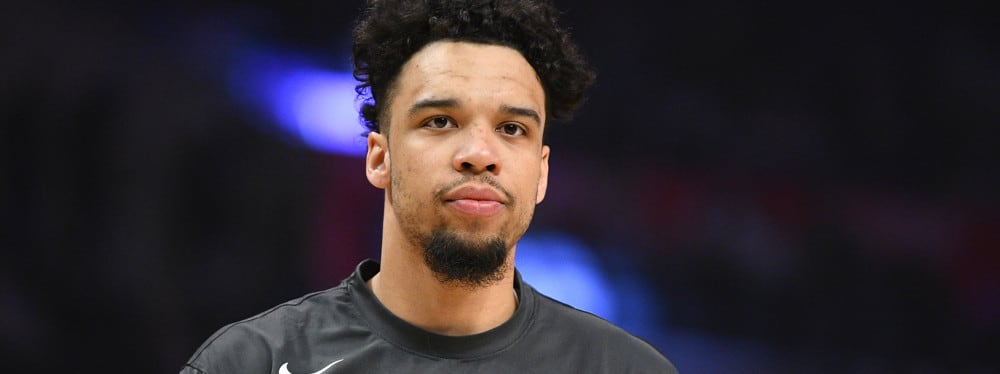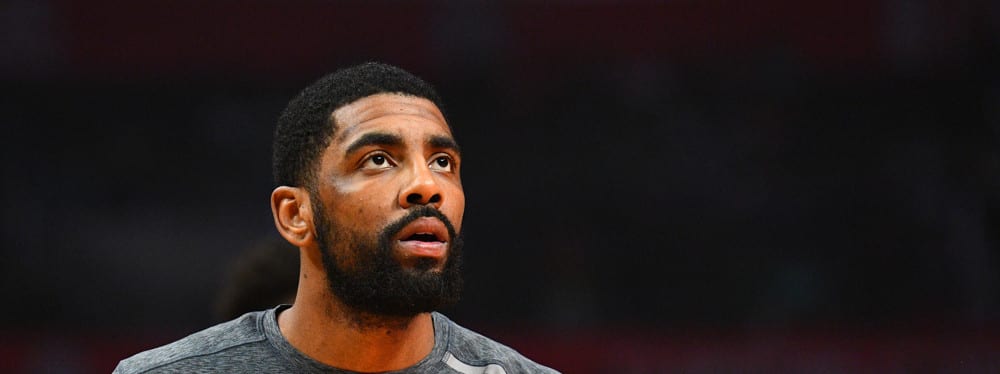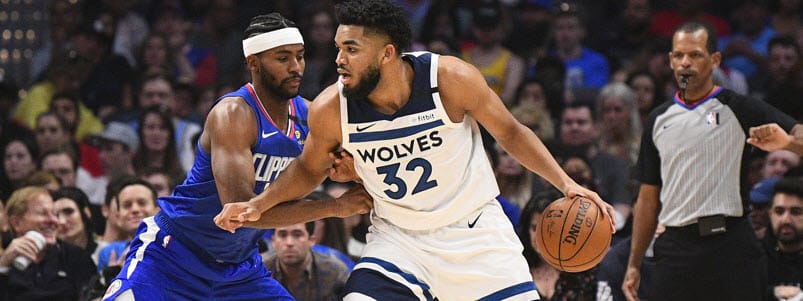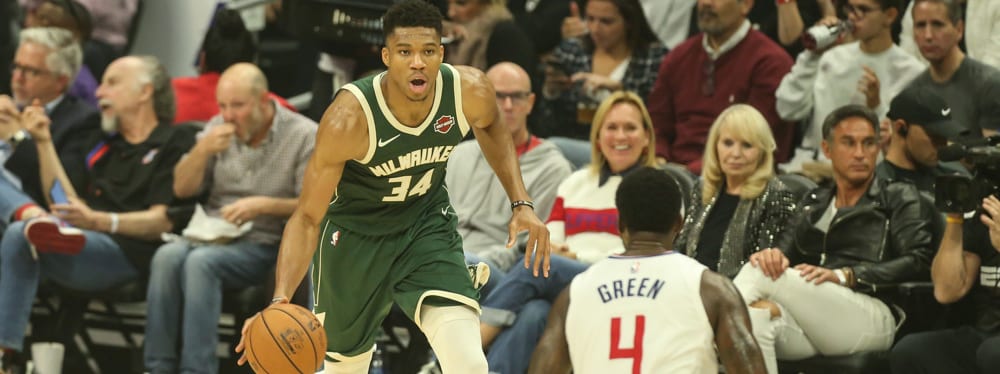Recent RotoWire Articles Featuring Meyers Leonard
See More
Despite seeing just 31 total minutes in the Heat's run to the NBA Finals, Leonard is back in Miami on a one-year, $9.4 million deal. During the regular season, Leonard started 49 of 51 appearances, averaging 6.1 points, 5.1 rebounds, 1.1 assists and 1.0 threes in 20.3 minutes. He actually could be in for a slightly expanded role this season, as the team lost Jae Crowder in free agency (and replacing him with Maurice Harkless). That said, Leonard is unlikely to become fantasy-relevant, even with a bump of a few minutes per game. He ranked 275th in per-game production last season. To be worth considering in standard leagues, Leonard would need to see 30-plus minutes of run, which seems unlikely at this juncture.
A July 1st trade to the Heat ended a seven-year, career-opening tenure in Portland for Leonard, but it arguably leaves the floor-stretching seven-footer in a relatively similar situation as the one he was mired in previously. While Miami shipped Hassan Whiteside to the Trail Blazers as part of the deal, that simply elevated 2017 first-round pick Bam Adebayo to the starting center role. Leonard has averaged 16.5 minutes or less in each of his last three seasons, even as he's encouragingly boosted his three-point success rate over the prior year in each of the last two campaigns. Leonard topped out at an impressive 45.0 percent success rate from behind the arc last season, and he closed out his Blazers career with a 30-point, 12-rebound double-double versus the Warriors the conference finals. The big man has proven capable of similarly impressive intermittent scoring spurts over the course of his career, but playing time limitations figure to keep his value primarily limited to deeper formats yet again this coming season. Leonard does boast superior size to Adebayo, but he only boasts a one-inch height advantage on a player with a similar offensive profile to him in Kelly Olynyk. The latter also has a two-year head start in the Heat's system on Leonard and has a more accomplished NBA track record, lending further credence to the notion Leonard could once again fill only a modest role in the center rotation despite the change in locale.
Leonard’s playing time disappointingly took a dip last season, his sixth, and he suited up for only 33 games while dealing with ankle and back injuries. The veteran had averaged double-digit minutes the three prior seasons as a member of the frontcourt rotation, but logged just 7.7 minutes per contest during the 2017-18 campaign. As expected with the reduced opportunity, Leonard’s shot attempts were down as well, and any hope for an eventual breakout as a starting-quality, floor-spacing seven-footer seem to be dashed at this point of his career. Leonard may manage to latch on to a roster spot again this season, but 2017 first-rounders Zach Collins and Caleb Swanigan appear much likelier to see minutes ahead of him.
Leonard came into last season with high hopes after securing a four-year, $42 million contract, but saw a fairly volatile workload throughout the year, which ultimately restricted his overall Fantasy impact. He ended up averaging just 16.5 minutes across 74 games, down from 21.9 minutes a season prior. Much of that can be attributed to added depth in the frontcourt, with the addition of Jusuf Nurkic at the trade deadline and guys like Maurice Harkless and Al-Farouq Aminu stepping up at power forward. However, Leonard didn't do much to help himself either, as he shot just 38.6 percent from the field and 34.7 percent from the three-point line, both of which declined from 2016-17. Overall, Leonard ended up lingering in a minor bench role with averages of 5.4 points, 3.2 rebounds, 1.0 assist and 1.0 three-pointer. Looking ahead to the upcoming campaign, Leonard's quest for playing time doesn't look promising. The Trail Blazers added Zach Collins and Caleb Swanigan in the 2017 NBA Draft, which will likely come at the expense of Leonard. With more bodies and less minutes available, Leonard's value should be on the decline
When the Blazers faced the Thunder on Opening Night last season, the starting five was embarking upon its third year together, and Chris Kaman and Joel Freeland were present to provide support to mainstays LaMarcus Aldridge and Robin Lopez. Leonard was thus contained to spot duty for the first two months, and another period post-All-Star break, but he really came into his own in the playoffs. Playing alongside Aldridge for significant stretches, Leonard finished Portland's first-round series defeat to the Grizzlies with one double-double and 10 three-pointers made across five games. Prior to losing Aldridge and Lopez in free agency, the Blazers, perhaps seeing the writing on the wall, acquired Mason Plumlee in a draft-day deal and inked Ed Davis to a three-year contract. The additions placed a cloud over Leonard's potential to transfer from bench fodder to a consistent member of the frontcourt rotation. However, as the offseason continued, general manager Neil Olshey intimated that Leonard is expected to start at power forward next to Plumlee, making him the seeming heir apparent to Aldridge. Leonard's ability to stretch the floor lends credence to that thought process, as he can coexist with paint dwellers Plumlee and Davis without clogging up driving lanes for guards Damian Lillard and C.J. McCollum. As a result, Leonard's per-36 production (13.9 points, 10.6 rebounds, 2.0 three-pointers, and 1.4 assists) and rare shooting touch (he shot 51 percent from the field, 42 percent from three-point land, and 94 percent at the free-throw line) are a recipe for success, as long as he sidesteps foul trouble (5.3 per 36 minutes in his career).
Whether it was the lack of playing time or his inability to make any strides as a defender, Meyers Leonard took a sizable step backward in his second year in the league, averaging 2.5 points (on 45-percent shooting) and 2.8 boards in nine minutes per game. Even when he garnered more consistent run after the All-Star break, the 11th selection of the 2012 NBA Draft experienced a reduction in overall production - 2.2 points and 2.6 rebounds in nine minutes per outing - while appearing in 19 of a possible 29 games on the way to 40 games played. One would think facing lesser competition, as the 22-year-old did at the Las Vegas Summer League, would improve his prospects, but an shoulder injury resulted in merely 6.7 points, 3.7 rebounds, 1.0 assist, and 1.0 block in 28 minutes per contest. In actuality, the bane of his existence, and his biggest hurdle to NBA success, is an inability to give out contact while avoiding a foul. Until his career mark of 5.6 fouls per 36 minutes turns around, Leonard will find it nearly impossible to be handed playing time with Chris Kaman and Joel Freeland in the picture.
While not set in stone, the 11th pick in the 2012 draft seems to be the frontrunner for Portland’s starting center this season. The 7-foot-1 Leonard may be pushed around at times as a rookie, like he was during Summer League, when he averaged 10.5 points (on 56 percent shooting), 8.3 rebounds, and 1.5 blocks over four contests. He should contribute boards, swats, an above average field goal percentage, fair free throw shooting, and the occasional double-double.













